Richmond is a town in south-west London, 8.2 miles (13.2 km) west-southwest of Charing Cross. It stands on the River Thames, and features many parks and open spaces, including Richmond Park, and many protected conservation areas, which include much of Richmond Hill. A specific Act of Parliament protects the scenic view of the River Thames from Richmond.

Bank robbery is the criminal act of stealing from a bank, specifically while bank employees and customers are subjected to force, violence, or a threat of violence. This refers to robbery of a bank branch or teller, as opposed to other bank-owned property, such as a train, armored car, or (historically) stagecoach. It is a federal crime in the United States.
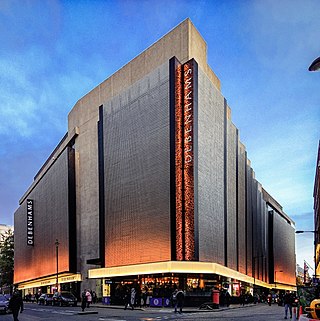
Debenhams plc was a British department store chain operating in the United Kingdom, Denmark and the Republic of Ireland, and is still operating as a franchise in seven Middle East countries. It was founded in 1778 as a single store in London and grew to 178 locations across those countries, also owning the Danish department store chain Magasin du Nord. In its final years, its headquarters were within the premises of its flagship store in Oxford Street, London. The range of goods sold included middle-to-high-end clothing, beauty, household items, and furniture.
The Woolwich Equitable Building Society was founded in Woolwich in 1847 and remained a local institution until after WWI when it began a modest regional expansion. This accelerated after WWII and the period from 1960 was notable for its acquisitions. Following deregulation, the Society diversified and became one of the largest national building societies.
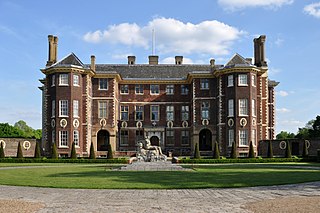
Ham is a suburban district in Richmond, south-west London. It has meadows adjoining the River Thames where the Thames Path National Trail also runs. Most of Ham is in the London Borough of Richmond upon Thames and, chiefly, within the ward of Ham, Petersham and Richmond Riverside; the rest is in the Royal Borough of Kingston upon Thames. The district has modest convenience shops and amenities, including a petrol station and several pubs, but its commerce is subsidiary to the nearby regional-level economic centre of Kingston upon Thames.

Arnotts is the oldest and largest department store in Ireland. It is located on Henry Street, on the north side of central Dublin. Together with the Brown Thomas chain of department stores, it is owned by UK-based Selfridges, which in turn is owned by Thai Conglomerate Central Group and Austria's Signa Holding.

House of Fraser and Frasers are a British department store chain with 25 locations across the United Kingdom and 2 in Ireland, part of Frasers Group. It was established in Glasgow, Scotland in 1849 as Arthur and Fraser. By 1891, it was known as Fraser & Sons. The company grew steadily during the early 20th century and in 1936 began a period of growth through acquisition which would continue for over forty years. House of Fraser Ltd was incorporated in 1941 and first listed on the London Stock Exchange six years later.
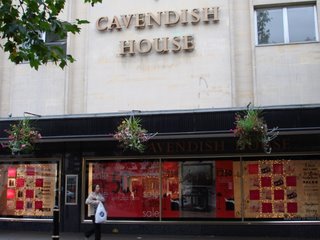
Cavendish House was Cheltenham's oldest department store, located on The Promenade. Its establishment was of great significance for Cheltenham's future reputation as a leading shopping centre. Known as 'Cavendish House' from its early days, its name was officially adopted with the registration of a limited liability company in 1883. The store became part of the House of Fraser group in 1970. The store closed in April 2024, after 201 years.
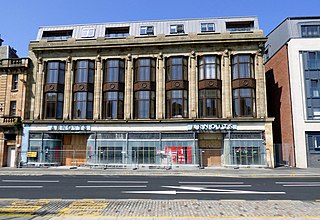
Arnotts was a department store in Glasgow, Scotland. It became part of the House of Fraser and one of their group brands, with the Arnotts brand then also being used by the company for department stores elsewhere in Scotland.
Owen Owen was a Liverpool-based operator of department stores in the United Kingdom and Canada. Beginning with a drapery shop in Liverpool, a chain of department stores was built up, often by taking over rival retailers. The company remained under Owen / Norman family control until the 1980s, and the brand ceased to be used in 2007.
Schofields was a department store that operated on the Headrow in Leeds, England, from 1901 to 1996. For much of the 20th century Schofields was regarded as being the pinnacle of shopping in Leeds city centre.
Dickins & Jones was a high-quality department store in London, England, which traded between 1835 and 2007, although tracing its origins to 1790. From 1835, the main store was in London's Regent Street. In its final years the store had branches at Epsom, Richmond, and Milton Keynes.
George Leonidas Leslie, who sometimes used the names George Howard and George Herbert, was an American bank robber and architect. He was involved in 80% of the bank robberies in the United States from 1869 to 1878, and was known as "The King of Bank Robbers".

Barkers of Kensington was a department store in Kensington High Street, Kensington, London. It began as a small drapery business, John Barker & Company, founded by John Barker and James Whitehead in 1870. Barkers grew rapidly to become one of London's largest and most well-known department stores.
Chiesmans was a department store group based in Lewisham, London. The business was established in 1884 as a general draper, expanding to become the largest department store in south-east London and operator of a network of branches stretching from Essex to the Isle of Wight. The group was acquired by House of Fraser in 1976. The former Lewisham flagship store closed in 1997.
Pontings was a department store based in Kensington High Street, London and operated from 1863 to 1970.
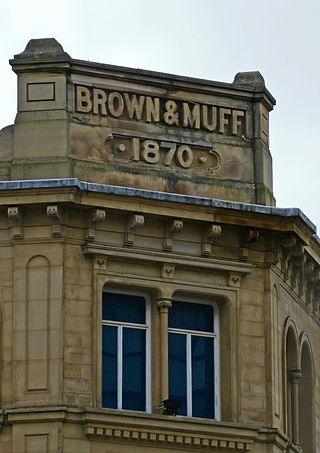
Brown Muff & Co, was a small chain of department stores based in Yorkshire, England, with its flagship store located in Bradford. It was purchased by House of Fraser in 1977.
The Ham bank murder occurred on 10 November 1976, at a branch of Barclays Bank in the Ham section of London, resulting in the murder of a bank teller working at the branch. The victim was Angela Mary Woolliscroft, fatally wounded by a shotgun.















